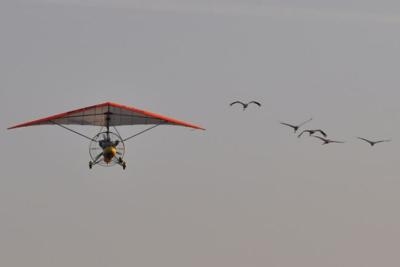Once Again Following An Ultralight 'Parent' On Their Way to Florida
Riding smooth air currents, five whooping cranes soared into Walker County in Northwest Alabama, near Birmingham, Tuesday. These birds, following Operation Migration’s ultralight aircraft, skimmed along at 5,700 feet and 70 miles per hour ground speed.

In the 12-year history of Operation Migration’s juvenile whooping crane winter migration project, this is the highest the ultralights have ever flown with birds. After flying 177 miles from Carroll County, Tennessee, to Walker County, Alabama, the cranes were grounded today due to choppy air currents, a condition which meant the flight would take almost four hours to the next stopover site in Chilton County, Alabama. The five ultralight-led cranes, completing their first fall migration, left White River Marsh State Wildlife Area in Green Lake County, Wisconsin on September 28, and are heading for St. Marks National Wildlife Refuge in the Florida panhandle. They have traveled 746 of the 1,101 miles to their destination.
“Compared to the last few years, the ultralight-led migration is making good time,” said Operation Migration Inc. CEO, Joe Duff. “Other than one stretch of bad weather in northern Illinois we’ve made good progress, so perhaps the earlier start date this year has paid off. We’re encouraged that at the current pace we will return to the pre-Christmas finish time of earlier migrations.”
To catch a rare glimpse of these whooping cranes, birders, wildlife enthusiasts, conservationists, and the general public are invited to gather to watch ‘flyovers’ as the ultralight-led flock departs each stopover location. These five juvenile whooping cranes and others that took part in the previous eleven ultralight reintroductions are hatched at the U.S. Geological Survey’s Patuxent Wildlife Research Center in Laurel, Maryland, and at the International Crane Foundation in Baraboo, Wisconsin. Chicks are raised under a strict isolation protocol, and to ensure the birds remain wild, handlers adhere to a no-talking rule and wear costumes designed to mask the human form.
Whooping cranes were on the verge of extinction in the 1940s. Today, there are only about 600 birds in existence, approximately 445 of them in the wild. Aside from the WCEP birds, the only other migratory population of whooping cranes nests at Wood Buffalo National Park in northern Alberta, Canada, and winters at Aransas NWR on the Texas Gulf Coast. A non-migratory flock of approximately 20 birds lives year-round in central Florida’s Kissimmee region, and an additional 17 non-migratory cranes live in southern Louisiana.
WCEP asks anyone who encounters a whooping crane in the wild to please give them the respect and distance they need. Do not approach birds on foot within 200 yards; remain in your vehicle; do not approach in a vehicle any closer than 100 yards. Also, please remain concealed and do not speak loudly enough that the birds can hear you. Finally, do not trespass on private property in an attempt to view or photograph whooping cranes.
Besides Operation Migration, other Whooping Crane Eastern Partnership founding members are the International Crane Foundation, Wisconsin Department of Natural Resources, U.S. Fish and Wildlife Service, the U.S. Geological Survey’s Patuxent Wildlife Research Center and National Wildlife Health Center, the National Fish and Wildlife Foundation, the Natural Resources Foundation of Wisconsin, and the International Whooping Crane Recovery Team.
Many other flyway states, provinces, private individuals and conservation groups have joined forces to WCEP by donating resources, funding and personnel. More than 60 percent of the project’s budget comes from private sources in the form of grants, public donations and corporate sponsors.
(Photo courtesy U.S. Fish and Wildlife Service)
 ANN's Daily Aero-Linx (04.13.24)
ANN's Daily Aero-Linx (04.13.24) ANN's Daily Aero-Term (04.13.24): Beyond Visual Line Of Sight (BVLOS)
ANN's Daily Aero-Term (04.13.24): Beyond Visual Line Of Sight (BVLOS) Airborne 04.09.24: SnF24!, Piper-DeltaHawk!, Fisher Update, Junkers
Airborne 04.09.24: SnF24!, Piper-DeltaHawk!, Fisher Update, Junkers Aero-News: Quote of the Day (04.14.24)
Aero-News: Quote of the Day (04.14.24) ANN's Daily Aero-Term (04.14.24): Maximum Authorized Altitude
ANN's Daily Aero-Term (04.14.24): Maximum Authorized Altitude



